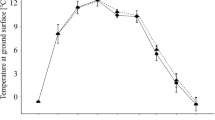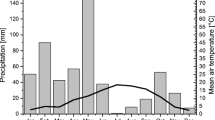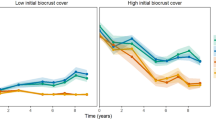Abstract
Background and aims
Given the broad distribution of bryophytes and their prominence in alpine and high latitude ecosystems, to generate a better understanding of how bryophyte communities influence soil CO2 efflux is essential for increasing our comprehension of the global C cycle.
Methods
We measured CO2 efflux from bryophyte-covered and bryophyte-removed soil surface in two subalpine ecosystems: a conifer dominated forest and an ericaceous dominated shrubland, on the east edge of Tibetan Plateau. In addition, soil temperature (T soil), soil water content (SWC), total soil organic C (SOC), dissolved organic C (DOC) and microbial community structure were measured as possible drivers of the bryophyte-effects.
Results
Bryophyte removal resulted in reduced floor (bryophyte + soil) and mineral soil CO2 efflux, SOC, DOC, microbial biomass C (MBC) and phospholipid fatty acid (PLFA) concentrations, and caused a change in soil microbial community in the two ecosystems. The higher soil CO2 emissions from the bryophyte-covered, relative to the bare soil, was not caused by the changes in T soil and SWC, rather, it was consistent with the higher SOC, DOC, MBC and/or the PLFAs contents in the plots with bryophytes.
Conclusion
Our results highlight bryophytes are regulators of soil C efflux in subalpine ecosystems. Incorporating the effects of bryophytes will help improve the accuracy of current ecosystem C cycling models.






Similar content being viewed by others
Abbreviations
- C:
-
carbon
- CO2 :
-
carbon dioxide
- T soil :
-
soil temperature
- SWC:
-
soil water content
- SOC:
-
total soil organic carbon
- DOC:
-
dissolved organic carbon
- MBC:
-
microbial biomass carbon
- PLFA:
-
phospholipid fatty acid
References
Bergeron O, Margolis HA, Coursolle C (2009) Forest floor carbon exchange of a boreal black spruce forest in eastern North America. Biogeosciences 6:1849–1864
Beringer J, Lynch AH, Chapin FS, Mack M, Bonan GB (2001) The representation of arctic soils in the land surface model: the importance of mosses. J Clim 14:3324–3335
Bona KA, Fyles JW, Shaw C, Kurz WA (2013) Are mosses required to accurately predict upland black spruce forest soil carbon in national-scale forest C accounting models? Ecosystems 16:1071–1086
Bossio DA, Scow KM, Gunapala N, Graham KJ (1998) Determinants of soil microbial communities: effects of agricultural management, season, and soil type on phospholipid fatty acid profiles. Microb Ecol 36:1–12
Botting RS, Fredeen AL (2006) Net ecosystem CO2 exchange for moss and lichen dominated forest floors of old-growth sub-boreal spruce forests in central British Columbia, Canada. For Ecol Manag 235:240–251
Budge K, Leifeld J, Egli M, Fuhrer J (2011) Soil microbial communities in (sub)alpine grasslands indicate a moderate shift towards new environmental conditions 11 years after soil translocation. Soil Biol Biochem 43:1148–1154
Cannone N, Binelli G, Worland R, Convey P, Guglielmin M (2012) CO2 fluxes among different vegetation types during the growing season in Marguerite Bay (Antarctic peninsula). Geoderma 189-190:595–605
Carleton TJ, Read DJ (1991) Ectomycorrhizas and nutrient transfer in conifer feather moss ecosystems. Can J Bot 69:778–785
Chapin FS III, Shaver GR (1988) Differences in carbon and nutrient fractions among arctic growth forms. Oecologia 77:506–514
Coxson DS (1991) Nutrient release from epiphytic bryophytes in tropical montane rain forest (Guadeloupe). Can J Bot 69:2122–2129
Coxson DS, Mcintyre DD, Vogel HJ (1992) Pulse release of sugars and polyols from canopy bryophytes in tropical montane rain forest Guadeloupe French West Indies. Biotropica 24:121–133
Cusack DF, Silver WL, Torn MS, Burton SD, Firestone MK (2011) Changes in microbial community characteristics and soil organic matter with nitrogen additions in two tropical forests. Ecology 92:621–632
Davey MC, Rothery P (1997) Interspecific variation in respiratory and photosynthetic parameters in Antarctic bryophytes. New Phytol 137:231–240
De Long JR, Dorrepaal E, Kardol P, Nilsson M, Teuber LM, Wardle DA (2016) Understory plant functional groups and litter species identity are stronger drivers of litter decomposition than warming along a boreal forest post-fire successional gradient. Soil Biol Biochem 98:159–170
De Sá Mendonça E, La Scala JN, Panosso AR, Simas FNB, Schaefer CEGR (2011) Spatial variability models of CO2 emissions from soils colonized by grass (Deschampsia antarctica) and moss (Sanionia uncinata) in Admiralty Bay, king George Island. Antarct Sci 23:27–33
Delucia EH, Turnbull MH, Walcroft A, Griffin K, Tissue D, Glenny D, Mcseveny TM, Whitehead D (2003) The contribution of bryophytes to the carbon exchange for a temperate rainforest. Glob Chang Biol 9:1158–1170
Elbert W, Weber B, Burrows S, Steinkamp J, Büdel B, Andreae MO, Pöschl U (2012) Contribution of cryptogamic covers to the global cycles of carbon and nitrogen. Nat Geosci 5:459–462
Federle TW (1986) Microbial distribution in the soil–new techniques. In: Megusar F, Gantar M (eds) Perspectives in microbial Ecology. Slovene Society for Microbiology, Ljubljana, pp 493–498
Fenton NJ, Bergeron Y, Paré D (2010) Decomposition rates of bryophytes in managed boreal forests: influence of bryophyte species and forest harvesting. Plant Soil 336:499–508
Flanagan LB, Kubien DS, Ehleringer JR (1999) Spatial and temporal variation in the carbon and oxygen stable isotope ratio of respired CO2 in a boreal forest ecosystem. Tellus 51B:367–384
Frostegård Å, Tunlidb A, Bååth E (1993) Phospholipid fatty acid composition, biomass, and activity of microbial communities from two soil types experimentally exposed to different heavy metals. Appl Environ Microbiol 59:3605–3617
Garcia-Pichel F, Johnson SL, Youngkin D, Belnap J (2003) Small scale vertical distribution of bacterial biomass and diversity in biological soil crusts from arid lands in the Colorado Plateau. Microb Ecol 46:312–321
Gaumont-Guay D, Black TA, Barr AG, Jassal RS, Nesic Z (2008) Biophysical controls on rhizospheric and heterotrophic components of soil respiration in a boreal black spruce stand. Tree Physiol 28:161–171
Gaumont-Guay D, Black TA, Barr AG, Griffis TJ, Jassal RS, Krishnan P, Grant N, Nesic Z (2014) Eight years of forest–floor CO2 exchange in a boreal black spruce forest: Spatial integration and long–term temporal trends. Agric For Meteorol 184:25–35
Gornall JL, Jónsdóttir IS, Woodin SJ, Van der Wal R (2007) Arctic mosses govern below–ground environment and ecosystem processes. Oecologia 153:931–941
Gornall JL, Woodin SJ, Jónsdóttir IS, Van der Wal R (2009) Herbivore impacts to the moss layer determine tundra ecosystem response to grazing and warming. Oecologia 161:747–758
Goulden ML, Crill PM (1997) Automated measurements of CO2 exchange at the moss surface of a black spruce forest. Tree Physiol 17:537–542
Gupta RK (1977) A study of photosynthesis and leakage of solutes in relation to the desiccation effects in bryophytes. Can J Bot 55:1186–1194
Gurlevik N, Kelting DL, Allen HL (2004) Nitrogen mineralization following vegetation control and fertilization in a 14–year–old loblolly pine plantation. Soil Sci Soc Am J 68:272–281
Hagemann U, Moroni M, Glibner J, Makeschine F (2010) Accumulation and preservation of dead wood upon burial by bryophytes. Ecosystems 13:600–611
Harden JW, O’Neill KP, Trumbore SE, Veldhuis H, Stocks BJ (1997) Moss and soil contributions to the annual net carbon flux of a maturing boreal forest. J Geophys Res 102:28805–28816
Hebel CL, Smith JE, Cromack K (2009) Invasive plant species and soil microbial response to wildfire burn severity in the Cascade range of Oregon. Appl Soil Ecol 42:150–159
Hinzman LD, Kane DL, Gieck RE, Everett KR (1991) Hydrologic and thermal–properties of the active layer in the Alaskan Arctic. Cold Reg Sci Tech 19:95–110
Hobbie SE (1996) Temperature and plant species control over litter decomposition in Alaskan tundra. Ecol Monogr 66:503–522
Hobbie SE, Schimel JP, Trumbore SE, Randerson JR (2000) Controls over carbon storage and turnover in high–latitude soils. Global Chang Biol 6:196–210
Jackson BG, Nilsson MC, Wardle DA (2013) The effects of the moss layer on the decomposition of intercepted vascular plant litter across a post-fire boreal forest chronosequence. Plant Soil 367:199–214
Kanerva T, Palojärvi A, Rämö K, Manninen S (2008) Changes in soil microbial community structure under elevated tropospheric O3 and CO2. Soil Biol Biochem 40:2502–2510
Laganière J, Paré D, Bergeron Y, Chen HYH (2012) The effect of boreal forest composition on soil respiration is mediated through variations in soil temperature and C quality. Soil Biol Biochem 53:18–27
Leckie SE, Prescott CE, Grayston SJ, Neufeld JD, Mohn WW (2004) Comparison of chloroform fumigation–extraction, phospholipid fatty acid, and DNA methods to determine microbial biomass in forest humus. Soil Biol Biochem 36:529–532
Lindo Z, Gonzalez A (2010) The bryosphere: an integral and influential component of the earth’s biosphere. Ecosystems 13:612–627
Lindo Z, Nilsson MC, Gundale MJ (2013) Bryophyte-cyanobacteria associations as regulators of the northern latitude carbon balance in response to global change. Glob Chang Biol 19:2022–2035
Longton RE (1992) The role of bryophytes and lichens in terrestrial systems. In: Bates JW, Farmer AM (eds) Bryophytes and lichens in a changing environment. Oxford University Press, New York, pp 32–76
Luthin JN, Guymon GL (1974) Soil moisture–vegetation–temperature relationships in central Alaska. J Hydrol 23:233–246
Mauclaire L, Pelz O, Thullner M, Abraham W, Zeyer J (2003) Assimilation of toluene carbon along a bacteria–protist food chain determined by 13C–enrichment of biomarker fatty acids. J Microbiol Meth 55:635–649
Moore TR, Bubier JL, Bledzki L (2007) Litter decomposition in temperate peatland ecosystems: the effect of substrate and site. Ecosystems 10:949–963
Nakane K, Kohno T, Horikoshi T, Nakatsubo T (1997) Soil carbon cycling at black spruce (Picea mariana) forest stands in Saskatchewan, Canada. J Geophys Res 102:28785–28793
Novak M, Zemanova L, Buzek F, Jackova I, Adamova M, Komarek A, Vile MA, Kelman WR, Stepanova M (2010) The effect of a reciprocal peat transplant between two contrasting central European sites on C cycling and C isotope ratios. Biogeosciences 7:921–932
O'Leary WM, Wilkinson SG (1988) Gram–positive bacteria C. In: Ratledge WM, Wilkinson SG (eds) Microbial Lipids, vol 1. Academic, London, pp 117–202
Orwin KH, Ostle NJ (2012) Moss species effects on peatland carbon cycling after fire. Funct Ecol 26:829–836
Proctor MCF (2000) Physiological Ecology. In: Shaw AJ, Goffinet B (eds) Bryophyte biology. Cambridge University Press, Cambridge, pp 225–247
Pypker TG, Unsworth MH, Bond BJ (2006) The role of epiphytes in rainfall interception by forests in the Pacific northwest. II. Field measurements at the branch and canopy scale. Can J For Res 36:819–832
Royer-Tardif S, Bradley RL, Parsons WFJ (2010) Evidence that plant diversity and site productivity confer stability to forest floor microbial biomass. Soil Biol Biochem 42:813–821
Schindlbacher A, Rodler A, Kuffner M, Kitzler B, Sessitsch A, Zechmeister-Boltenstern S (2011) Experimental warming effects on the microbial community of a temperate mountain forest soil. Soil Biol Biochem 43:1417–1425
Schmitt A, Glaser B (2011) Organic matter dynamics in a temperate forest soil following enhanced drying. Soil Biol Biochem 43:478–489
Sedia EG, Ehrenfeld JG (2005) Differential effects of lichens, mosses and grasses on respiration and nitrogen mineralization in soils of the New Jersey pinelands. Oecologia 144:137–147
Sharratt BS (1997) Thermal conductivity and water retention of a black spruce forest floor. Soil Sci 162:576–582
Skre O, Oechel WC (1981) Moss functioning in different taiga ecosystems in interior Alaska I. Seasonal, phenotypic, and drought effects on photosynthesis and response patterns. Oecologia 48:50–59
Smithwick EAH, Turner MG, Metzger KL, Balser TC (2005) Variation in NH4 + mineralization and microbial communities with stand age in lodgepole pine (Pinus contorta) forests, Yellowstone National Park (USA). Soil Biol Biochem 37:1546–1559
Street LE, Subke JA, Sommerkorn M, Sloan V, Ducrotoy H, Phoenix GK, Williams M (2013) The role of mosses in carbon uptake and partitioning in arctic vegetation. New Phytol 199:163–175
Sun SQ, Wu YH, Wang GX, Zhou J, Yu D, Bing HJ, Luo J (2013) Bryophyte species richness and composition along an altitudinal gradient in Gongga Mountain, China. PLoS One 8:e58131
Swanson RV, Flanagan LB (2001) Environmental regulation of carbon dioxide exchange at the forest floor in a boreal black spruce ecosystem. Agr For Meteorol 108:165–181
Thoms C, Gleixner G (2013) Seasonal differences in tree species’ influence on soil microbial communities. Soil Biol Biochem 66:239–248
Turetsky MR (2003) The role of bryophytes in carbon and nitrogen cycling. Bryologist 106:395–409
Van Cleve K, Yarie J (1986) Interaction of temperature, moisture and soil chemistry in controlling nutrient cycling and ecosystem development in the taiga of Alaska. In: Van Cleve K, Chapin FS III, Flanagan PW, Viereck LA, Dyrness CT (eds) Forest ecosystems in the Alaskan taiga. A synthesis of structure and function. Springer, New York, pp 160–189
Vance E, Brookes PC, Jenkinson DS (1987) An extraction method for measuring soil microbial biomass C. Soil Biol Biochem 19:703–707
Waldrop MP, Zak DR, Sinsabaugh RL (2004) Microbial community response to nitrogen deposition in northern forest ecosystems. Soil Biol Biochem 36:1443–1451
Wang YS, Wang YH (2003) Quick measurement of CH4, CO2 and N2O emissions from a short-plant ecosystem. Adv Atmos Sci 20:842–844
Wang C, Bond Lamberty B, Gower ST (2003) Carbon distribution of a well–and poorly–drained black spruce fire chronosequence. Glob Chang Biol 9:1066–1079
White DC, Stair JO, Ringelberg DB (1996) Quantitative comparisons of in situ microbial biodiversity by signature biomarker analysis. J Ind Microbiol Biotech 17:185–196
Wickland KP, Neff JC (2008) Decomposition of soil organic matter from boreal black spruce forest: environmental and chemical controls. Biogeochemistry 87:29–47
Williams TG, Flanagan LB (1998) Measuring and modeling environmental influences on photosynthetic gas exchange in sphagnum and Pleurozium. Plant Cell Environ 21:555–564
Wilson JA, Coxson DS (1999) Carbon flux in a subalpine spruce-fir forest: pulse release from Hylocomium splendens feather–moss mats. Can J Bot 77:564–569
Woodin SJ, van der Wal R, Sommerkorn M, Gornall JL (2009) Differential allocation of carbon in mosses and grasses governs ecosystem sequestration: a 13C tracer study in the high Arctic. New Phytol 184:944–949
Wu YP, Ding N, Wang G, Xu JM, Wu JJ, Brookes PC (2009) Effects of different soil weights, storage times and extraction methods on soil phospholipid fatty acid analyses. Geoderma 150:171–178
Yuan W, Liu S, Dong W, Liang S, Zhao S, Chen J, Xu W, Li X, Barr X, Black TA, Yan W, Goulden ML, Kulmala L, Lindroth A, Margolis HA, Matsuura Y, Moors E, van der Molen M, Ohta T, Pilegaard K, Varlagin A, Vesala T (2014) Differentiating moss from higher plants is critical in studying the carbon cycle of the boreal biome. Nat Commun 5:4270
Zelles L (1997) Phospholipid fatty acid profiles in selected members of soil microbial communities. Chemosphere 35:275–294
Zelles L (1999) Fatty acids patterns of phospholipids and lipopolysacharides in the characterisation of microbial communities in soil: a review. Biol Fert Soils 29:111–129
Zimov SA, Chuprynin VI, Oreshko AP, Chapin FS, Reynolds JF, Chapin MC (1995) Steppe–tundra transition—a herbivore driven biome shift at the end of the Pleistocene. Am Nat 146:765–794
Zogg GP, Donald RZ, David BR, Neil WM, Kurt SP, David CW (1997) Compositional and functional shifts in microbial communities due to soil warming. Soil Biol Biochem 61:475–481
Acknowledgements
The authors appreciate the support of the Alpine Ecosystem Observation and Experiment Station of Mt. Gongga and the Yanting Agro-ecological Experimental Station of Purple Soil, institute of mountain hazards and environment, CAS. This work was supported by the National Natural Science Foundation of China (grant numbers. 41473078, 41273096); the Key Laboratory of Mountain Surface Processes and Ecological Regulation, CAS.
Author information
Authors and Affiliations
Corresponding author
Ethics declarations
Conflict of interest
The authors declare that they have no conflict of interest.
Additional information
Responsible Editor: Hans Lambers.
Rights and permissions
About this article
Cite this article
Sun, SQ., Liu, T., Wu, YH. et al. Ground bryophytes regulate net soil carbon efflux: evidence from two subalpine ecosystems on the east edge of the Tibet Plateau. Plant Soil 417, 363–375 (2017). https://doi.org/10.1007/s11104-017-3264-3
Received:
Accepted:
Published:
Issue Date:
DOI: https://doi.org/10.1007/s11104-017-3264-3




